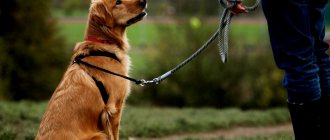How to calm your dog during a thunderstorm
Dogs are very often afraid of thunderstorms, and this is usually associated with thunder - sharp and loud sounds. To prevent dog anxiety in such cases, you need to accustom your pet to such things - use pyrotechnics, play audio recordings with similar noises. Along the way, it makes sense to distract the dog by offering it games, treats or other activities. If a thunderstorm catches you with an unprepared dog, try to find shelter. Anything will do, for example, an entrance canopy. At the same time, remember that if there is no shelter, your four-legged friend will most likely run to look for it on his own, so try to quickly find it or do it. For example, you yourself can play the role of a kind of “shelter” by hugging your pet and wrapping your arms around it. At the same time, distracting the dog from thunder with toys and treats is not only possible, but also necessary - this will have a positive effect in the future.
Verbal communication
How to calm a dog during aggressive barking? In such a situation, you should not attack the dog screaming. It is better to calmly tell your pet about his inappropriate behavior. Naturally, your pet will not understand the essence of what was said. However, he will pick up the intonation of words and the mood of the owner.
You can also teach your four-legged friend to respond to the command “quietly”. How to calm a dog using this method? After another unreasonable attack of barking, it is worth showing the dog a treat. Keep the treat in your dog's sight until he stops being nervous. Then you should give the command “quiet” and offer the pet food. It is necessary to continue this training until the dog understands that receiving a reward becomes possible only with complete silence.
How to calm your dog while grooming
Grooming is a process that is very closely related to touching the dog. Therefore, a pet that is being cut must trust either its executor or the one with whose will all this is happening (in case it is not the owner who is cutting the hair, but the hairdresser). That is, the most important and necessary thing in this case is a confident owner who knows exactly what he is doing. If a dog understands that it can trust its owner, it will calm down on its own. If the dog is still terrified of the hairdresser, the best option would be to distract the animal from the problem with the same toys or treats. Well, if they don’t help either, calming pills or substances will do, be it “cat-bayun” or the well-known “valerian”. It’s worth adding one more way to calm your four-legged friend - take him for a walk before the haircut, tire him out with games. A powerless creature cannot and will not resist. It is worth noting that the method of exhausting you with a walk can also play a role before other exciting events in your dog’s life. For example, before going to the veterinarian: this person will be as much a stranger to the animal as a hairdresser.
Ignoring your pet's demands
How to calm a dog? In some situations, it is enough to simply stop following the lead of your four-legged friend. Some pets rely on barking to get their owner's attention. To prevent this behavior from causing daily irritation, you need to give up the immediate gratification of your pet’s desires.
Naturally, this approach will not immediately get rid of the problem. You will have to spend a lot of time on training. However, the result will not force you to return every time to the search for solutions to answer the question of how to calm your dog.
It is extremely important for the owner to learn to distinguish the nature of barking. Often he says that the dog needs a walk. However, most often dogs try to satisfy minor desires in this way, in particular, to attract attention to themselves in order to receive affection from the owner or a favorite treat. In such situations, you should not react to the impulsive behavior of your four-legged friend.
READ Otodectosis in cats - treatment and symptoms
How to calm your dog before a walk
Puppies usually worry before going for a walk, doing this due to their ignorance of the world around them. But there are cases of neurosis in adult animals. There is always only one way out - to train, distract and “not pay attention.” Let your pet understand that a walk is as ordinary as eating or sleeping. To calm down in a single case of fear, the owner is required, or rather, contact with him. Sit down in front of your dog, pet him, look him in the eyes with confidence and say something firmly but calmly. What doesn’t really matter, the main thing is to maintain the intonation. You can also use sedatives, but you should not abuse them - such a practice is not encouraged. In any case, remember that walks are an integral part of your friend’s life, so he will definitely get used to them. This is a matter of time and only if there is nothing specific on the street that bothers or irritates the dog.
Establishing a regime
In everyday life, dogs rely on a set of standard programs of action. Pets remain calm unless they find themselves in emergency situations that do not correspond to the established routine.
READ Nobivak for cats and kittens
How to calm your dog so that the problem does not return? It is enough to create a clear schedule for your four-legged friend. At certain times it is necessary to go for a walk with your pet. Next, you need to offer the dog food, and then leave it alone for a while. In the afternoon, another family member should repeat similar actions.
In fact, you shouldn't create too harsh a regime for your dog. You just need to act in a certain sequence so that information about the behavior desired by the owner is deposited in the long-term memory of the four-legged friend, and the standard set of actions becomes part of everyday life.
How to calm a dog when stressed
In principle, stress in our pets is present in all of the above-mentioned cases, so if the dog begins to worry for no apparent reason, he is most likely afraid of the unknown. As in previous cases: fear of loud sounds, fear of other people's touches, fear of an unknown street. Therefore, just combine everything that we have already learned about. Distract the dog, protect the dog, give him confidence, shelter or, at worst, a pill. Well, to reduce such cases, introduce your pet to the outside world: the number of his fears is inversely proportional to the amount of his knowledge about what is outside his native kennel.
Natural sedatives
A sedative for dogs at home should only be used in situations where you know in advance that your pet will face a stressful situation.
Indications for taking such drugs are as follows:
- barking for no reason;
- constant feeling of fear;
- frequent howling;
- The dog is constantly trying to hide somewhere.
All these situations indicate that you need to urgently begin treatment before your pet becomes depressed or begins to show aggression.
Childbirth of a Chihuahua: what you need to know and how to help your pet
Benzodiazepines
This type of sedative includes the following medications:
- Fitex are drops that help suppress intraspecific aggression. This universal remedy is also used to reduce hyperactivity and to relieve stress at exhibitions or during transportation.
- Kot Bayun is a herbal medicine. It helps to keep an aggressive and hostile animal under control.
This group of sedatives is rarely prescribed, if necessary. They are most often used in the form of injections to immobilize an animal for surgery under general anesthesia or diagnostic procedures. Only a doctor can give a sedative injection for dogs directly at the clinic.
This group of drugs has quite a few contraindications and side effects; they are absolutely not suitable for independent use.
Less dangerous sedatives for dogs are natural, plant-based drugs. Extracts of medicinal plants have a unique biochemical composition, are rich in components and organic compounds that have a beneficial effect on the nervous system of animals, suppress feelings of fear, and help cope with stress.
Stop stress for dogs
Effective herbal anti-stress preparations for dogs in drops:
- Cat Baiyun. Can be used not only for cats, but also for dogs of various breeds and age groups, starting from one year. The drug has a mild sedative effect, relieves fear, anxiety, and eliminates panic. In case of severe stress, the dog is given the remedy on an empty stomach two to three times a day.
- Fitex. A fairly effective, safe sedative for animals, which contains exclusively natural ingredients, extracts of medicinal herbs (motherwort, mint, valerian, skullcap, hops). To normalize the emotional state of your beloved pet, dogs are given Fitex three times a day to relieve stress at the rate of one drop per kilogram of the dog’s body weight.
- Hormone Balancer Flower Essence. Stop-stress drug is available in drops. It is one of the very effective drugs that veterinarians prescribe not only as a sedative, but also to correct behavior and normalize hormonal balance, usually during the period of sexual heat, in case of false pregnancy. dosage: seven drops for dogs of any age, all breeds.
- Stop stress in drops. 1 ml contains 100 mg of phenibut, a balanced complex of aqueous extracts of medicinal plants, such as: peppermint, peony, Baikal skullcap, hops, motherwort, valerian. It is one of the safest, most effective sedatives for dogs and cats. It has a pronounced tranquilizing, psychostimulating, antioxidant effect. The drug improves the functional state of the brain by activating metabolic processes in tissues and speeds up cerebral circulation. Stop stress in drops for dogs increases the body's adaptive capabilities to environmental stress factors. Does not provoke side effects, is not addictive. Prescribed to dogs for the correction of behavioral psychogenic disorders. Dogs are given 3-5 drops three days before visiting an exhibition, before transportation, visiting a veterinary hospital and for another three days after.
- Jerob B—Calm Dietary Supplement. A soothing tincture containing extracts of medicinal plants. Contains the amino acid L-tryptophan. Dosage: one teaspoon for every 4.5 kg of dog's weight, twice a day.
- Phospasim. Homeopathic complex sedative drug. Can be used for dogs of various breeds and age groups. There are no contraindications for use. The dosage is calculated based on the dog's weight. To relieve stress and normalize the emotional state, Fospasim is given 1-2 times a day for one to two weeks.
Fitex – soothing drops for dogs, cats
Use potent sedatives for animals in tablets, sprays, drops only in case of urgent need.
- “Adaptil” is a spray that is plugged into a socket and sprayed around the apartment. Recommended for stressful situations, such as fear of fireworks, thunderstorms, when a puppy is moving to a new family, after a visit to the veterinarian, etc.
- “SENTRY Calming Collar” is a calming collar that helps the dog calm down in stressful situations.
- “Help Dog” is a pheromone spray that calms dogs in various stressful situations.
- Zylkene is a food additive in powder form added to feed. Helps the animal cope with stressful situations more easily.
READ Cats that look like Georgians. Description of the oriental breed of cats similar to Georgians
These are fairly gentle sedatives for dogs that will help cope with difficult moments in your life. Before going to the vet or when a thunderstorm is approaching, you can give your pet 5-20 drops, depending on the weight of the animal. The permissible dose should be calculated by the veterinarian, so discuss this issue with him in advance.
In a very stressful situation, the veterinarian may prescribe passionflower. It is usually also prescribed if there is strong aggression or jealousy, for example if a child is born into the family, and the dog perceives him as a competitor. Finally, this list is completed by the Baikal skullcap. This is the herb that has the most powerful sedative effect.
There are also more serious means, which we will talk about now.
A situation is possible when a street animal displays an aggressive attitude. If you are the target of an attack, do not run away. The dog's instinct of pursuit is triggered, it will catch up. Stop panicking, dogs sense someone else's fear. Remain calm, the animal will feel insecure and will be less aggressive. In a situation of attack, it is better to stop, perhaps you were perceived as a danger.
If this is so, animal interest in you will be lost. Make fists to protect your fingers. Shout loudly “Ugh!” or “Back!” It is difficult to defend against an attack. Try to hit the nose and stomach. The ideal technique is to press the dog's head to the ground, pressing down on the neck. The beast will not be able to bite. The aggressor will calm down and run away, admitting defeat. Protect your face and neck from attack. If you are injured, go to the hospital. A minor scratch can cause an infection.
There are many methods to calm dogs. The most magical thing is a kind attitude towards your pet. The owner is both a friend and a leader for his pet. Once you know your pet's temperament, develop optimal behavior. Educate, don’t pamper or punish again. The pet begins to mischief due to lack of attention, due to lack of joint games. Spend more time with the one you tamed. It was you who got the dog, not the dog who got you.
How to calm an aggressive dog
Aggression in a dog is a serious problem that must be solved. There are three main reasons why your pet will behave this way: malaise, pseudo-pregnancy (in bitches) and a third case, which will be discussed separately. In the first case, carefully diagnose the pain and, if possible, help. If everything is really bad, contact your veterinarian. In the second case, it is enough to hide toys from the bitch that she may mistake for her cubs. Eliminate the source of the neurosis and it will go away. If this doesn’t help, the veterinarian will help. The third case is a “special” case in its own way, and is associated with the psychology of our four-legged animal. After all, a dog is a pack animal, and a pack needs a leader. If you are not one in the eyes of your dog, he will try to take the place of the boss on his own. In such cases, do not try to scream, hit your pet or do anything else like that, as you will only make the situation worse. Show your dog confidence by giving him commands and praising him for following them. Show her that you control what is happening around you and are at the highest level of the hierarchical ladder. If it doesn’t work out, don’t be afraid to turn to dog handlers. After all, they work with their own and other people's pets for a significant part of their lives.
If the aggression does not come from your pet, follow simple instructions. Firstly, do not run away - the dog will start the chase, following its instincts. And, believe me, the chase will end in success for the four-legged one. Secondly, don't try to panic. The dog will see fear and think that if you are afraid of it, then there is a reason for this. Plus, don’t forget that a panicking enemy is much less scary than a confident one. Thirdly, clench your fingers into a fist - in case of a fight, this will protect them. Fourth, try to drive the animal away with a firm tone. Use the “Back!” commands. or “Ugh!”
If a fight cannot be avoided, try to hit the nose and stomach, but do not forget that your opponent will be much more nimble and nimble than you. The best option is to put pressure on the dog's neck and press his head to the ground. This way you will deprive your opponent of the ability to use fangs (but don’t forget about the claws). Remember also that defense during a fight is no less important than attack. Cover your neck and face, and if you receive any injuries, consult a doctor - the possibility of infection has not been canceled.
What to do if your dog whines at night
As a rule, adult dogs sleep at night if their day has been eventful and active, the pet is well-fed and healthy. Therefore, most often small puppies make cutting, unpleasant sounds at night, and this is most often explained not only by a sharp change in their usual environment, but also by fear and loneliness.
Important! If the puppy is not yet three months old, the baby howls and whines at night when he is left alone or locked alone in a room, never use physical violence or yell at the small pet. But encouraging such behavior is unacceptable. Act consistently and persistently.
During the first few days, whining is quite normal. He is frightened by new surroundings, smells, sounds. Some dog breeders recommend taking your pet to the bed. But dog experts do not recommend doing this. The puppy will get used to sleeping with you and it will be difficult to accustom an older pet to a place.
To stop your puppy from whining:
- Organize a comfortable bed or house for the new member of your family.
- If possible, do not leave the dog alone for a long time, and especially do not lock the puppy in a crate or in another room.
- Protect your dog from stress and negative emotions. The period of adaptation and socialization should be as calm and favorable as possible.
If the puppy is a little over a month old, at this age it is not advisable to separate him from his mother. But if this happens, place the dog bed near your bed and as soon as the baby whines, calm him down and pet him. Once the puppy calms down, praise him.
Gradually move the lounger further away from the bed and react less to whining. Pay more attention to your pet so that he gets used to his new home faster and can more easily endure separation from his mother. In order for the puppy to better cope with separation from his mother dog, ask the breeders for toys, a cloth, or things that have retained familiar smells . Place them near the bed or in the house where your small pet sleeps, and he will behave more confidently and calmly. You can also use a heating pad or a bottle filled with warm water. Wrap it in soft cloth and place it near the puppy.
If the puppy, having adapted to new conditions, continues to howl and whine at night, leave the light or night lamp on. Approach the dog and calm it down in a gentle tone. If the whining does not stop, perhaps the puppy does not want to sleep and is bored. Place toys and tooth sharpeners near the baby. After playing enough, the dog will get tired and sleep peacefully.
Gradually accustom your dog to the command “Place”, “Fu”, “No” or any other prohibition commands. Give the command in a strict tone, and as soon as the dog has shown obedience, reward it with a gentle intonation or a treat. To prevent the puppy from getting bored when you are not at home, leave him various toys. Otherwise, the dog will not only howl, but will also begin to damage furniture and wallpaper.
Physical activity is equally important. After quarantine, walk your dog several times a day, gradually increasing the walking time. Accustom your puppy to communicate with his relatives, so that he then reacts normally to other dogs and animals.
How to calm your neighbor's barking dog
There are two methods to calm your neighbor's barking dog - peaceful and not so peaceful. The first is to try to make friends with the animal or simply show that you are not dangerous to it. Remember? “Eliminate the source of the neurosis and it will go away.” This can be done by feeding (a simple method, but which has negative consequences), ostentatiously ignoring aggression, or simply developing friendly relations with a neighbor, who should be an authority for the dog. A not very peaceful method is to wear out someone else's dog with something. For example, ultrasound. But if you decide to go this route, keep in mind that the animal may greatly worsen its attitude towards you, which may subsequently come back to haunt you with the need to defend itself.
Creating new tasks
A dog's hyperactivity may be associated not only with psychological factors, but also with the need to expend excess energy. Perhaps the dog is simply not getting enough physical activity. Therefore, she tries to attract the owner’s attention by being excessively irritable.
To calm your pet down, at the first change in behavior, you should offer him a new task. For example, you can use your four-legged friend to play with a ball or a rubber bone. You should also teach your dog to fetch things on command, be it slippers, a leash, a bag, etc. By focusing on the proposed “work”, the animal will be distracted from external factors that cause irritability and lead to increased activity.
Emergency relief from a panic attack is one thing, but what if longer treatment is needed? What sedative can be given to dogs in a course? For the treatment of phobic disorders, the drug of this group called “Spitomin” is best suited. It is also used to treat urinary incontinence or various anxiety disorders.











